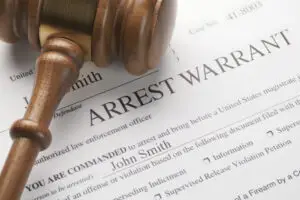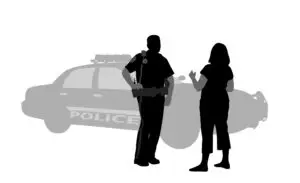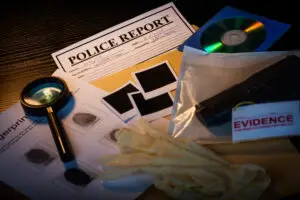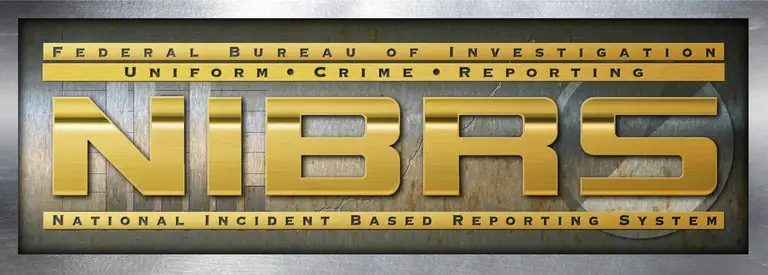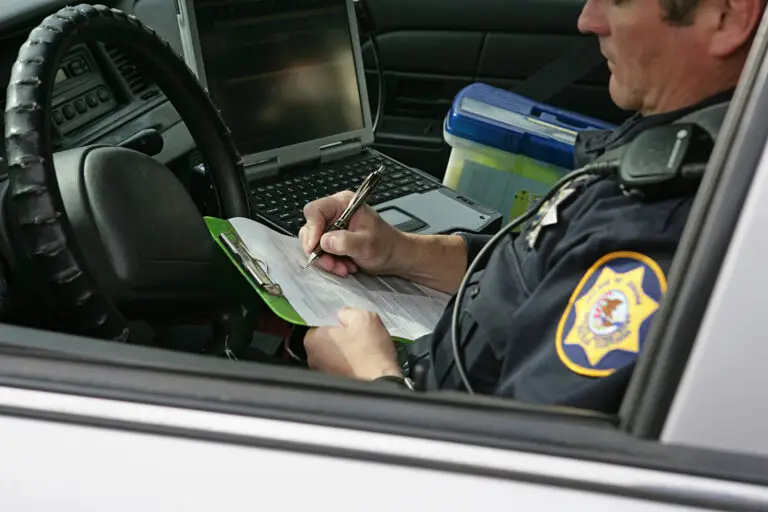
Always respect the period, and your readers will be appreciative albeit subconsciously.
~ Barry M. Baker Tweet

Detective Lieutenant Barry M. Baker (ret.) is a 32 year veteran of the Baltimore Police Department.
Police report writing is important on so many levels. One can argue that a perfect crime is simply one that is not reported. If a crime is not reported, no investigation will follow, no arrest will occur, and no prosecution will be pursued. When a victim decides not to report a crime to police, that’s a personal decision by the victim. However, when the crime is reported to police, it is your responsibility to document and thoroughly investigate the incident.
The Preliminary Police Report
This is where police report writing begins, because every police investigation begins with a police officer’s preliminary report. Your preliminary report can be just the beginning, or it can encompass and conclude an entire investigation. It all depends on the complexity of circumstances, and your investigative abilities.
Police Report Writing Guidelines
The information fields in report headings will vary among police departments, but all will generally require the same information. Your report heading will provide you a guide to the 5 W’s for police report writing:
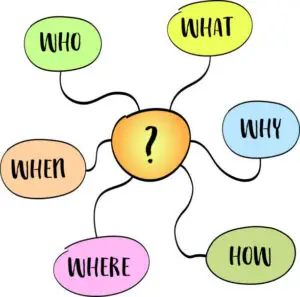
WHO:
Complainant / Victim
A victim is a person who is harmed, injured or killed accidentally or during the commission of a crime. Complainant will be used for lesser incidents.
Reporting Person
The complainant or victim will usually be the reporting person; however, circumstances can dictate otherwise. A person reporting a missing person, or a witness reporting a crime, when the victim is unable, will be the reporting person.
Witness
A witness can be an eyewitness to the incident, or another person who can provide relevant information regarding the incident.
Suspect
A suspect is the person suspected of committing the crime that is being reported. Record the identity of the suspect if known; otherwise, provide a complete physical description of the suspect.
WHAT:
This field will list the type of crime or other incident. Some examples would include: Robbery; Burglary; Lost Property; Recovered Property or countless other incidents.
WHEN:
Date and Time of Occurrence
This is usually simple to establish; however, people sometimes wait days or longer to report a crime. A victim of sexual assault may delay reporting, and an inaccurate date can be disastrous for a subsequent prosecution.
Date and Time Reported
If you encounter an incident in progress, the time of occurrence and time reported will be the same. Otherwise, the time reported will be subsequent to the incident’s conclusion.
Use of Military Time: Most police departments use the 24 hour clock versus the 12 hour clock, because it is less prone to error. It’s easy to master, and it does eliminate any mistakes that might present between am and pm. Lawyers aren’t crazy about military time, because they complain they have to translate it for juries. MilitaryTimeChart.com
WHERE:
The location of the incident should be as accurate as possible. A street address is the most common entry to use in this field.
WHY:
When it comes to crimes, why is synonymous with motive. As a matter of law, motive is not a necessary element in proving a person’s guilt beyond a reasonable doubt. However, everybody likes to know why things happen, and everybody includes police, lawyers, judges and juries. In most instances, the whys will be apparent from the facts described in your narratives. Just take care not to speculate; because, speculation has no place in police report writing.
HOW:
Once you know what happened, you simply describe how it happened. How is important for reporting crime, because how the crime was committed will establish the elements of the crime. A victim may tell you he was robbed, and he was robbed by his definition. An unknown suspect(s) broke into his car, and the suspect(s) stole his laptop. However, the UCR (Uniform Crime Reporting) definition is different from his, because the victim was not present when the theft occurred. The crime reported will be Theft versus Robbery. Had the victim been present and placed in fear by the suspect, the crime would be elevated to Robbery.
Constructing Your Police Report Narrative
You’ve entered the information into the required fields of your report, and you’re ready to begin your narrative of events. The narrative will be a clear, concise, correct and complete description of the incident.
Readability
You’re writing for others, and you want readers to easily comprehend what you’ve written.
Report will be written in First Person - Past Tense
You’re a character in a story you’ll be narrating, and you’ll refer to yourself with the pronouns “I” and “me.”
Chronological Order
Police report writing isn’t an exercise in creative writing, so describing events in chronological order should be a natural progression. Your report will begin by describing your entry into the event, and you’ll receive notification of the event in one of three ways: You’ll be directed by your police dispatcher, or the victim or another will approach you. The third way is when you happen upon the event while the crime or incident is in progress. You’ll continue by describing events as they transpired.
Use Active Voice
The easiest way to distinguish active voice versus passive voice is that active voice conveys a statement more directly. It’s easy to slide into passive voice, so you’ll need to review and edit your report. Remove words or phrases that are extraneous or redundant.
Identifying Individuals in the Narrative
Always use proper names when referring to victims and witnesses (e.g., Victim Smith or Witness Jones). Never use numbers except in the case of multiple suspects whose identities are unknown.
Use of Pronouns
The use of pronouns is fine, but don’t use them too liberally. Police report writing is about clarity, and you don’t want to confuse the reader to which character you’re referring.
Punctuation
When police report writing contains bad punctuation, it reflects poorly on the writer. Every report you write should be a combination of Simple; Compound; Complex and Compound-Complex Sentences.
Example Sentences:
Simple: The suspect fled the scene.
Compound: The victim screamed for help, and the suspect fled the scene.
Complex: Although the victim complied, the suspect pushed the victim to the ground.
Compound-complex: Although the victim complied, the suspect pushed the victim to the ground; after which, the suspect fled the scene.
Sentence Length
Twenty (20) words maximum is the perfect sentence. Of course, you can go a few over, but only a few. Every sentence ends with a period, and the period is a remarkable piece of punctuation. If only for a micro-second, it gives the reader’s brain time to absorb and comprehend the thought conveyed. Think about the times you’ve read a sentence containing 40 or even 50 plus words. Always respect the period, and your readers will be appreciative albeit subconsciously.
Paragraph Length
Like sentence length, paragraph length is better shorter than longer. Your paragraphs should contain more than two sentences, and the content should not exceed 200 words.
Use of Subheadings
Subheadings are useful to the reader, and you are writing for the reader. They won’t be an issue for short reports, but you’ll write reports where you’ll perform multiple tasks. For example, you may make notifications; collect evidence, interview multiple witnesses, or respond to additional locations. When your report reaches a length where quickly locating specific information becomes difficult, the solution is subheadings.
Length of Report
There are no word counts or page length requirements for police report writing. Each report will be unique to its circumstances.
More Points for Police Report Writing
Don’t Jump to Conclusions
Police officers are as susceptible to human nature as anyone, and jumping to conclusions is no exception. If your opinions and speculations match with observations, evidence and verifiable facts, that’s okay. Just don’t work it the other way around. Your investigations will be memorialized in your police report writing, and you don’t want to look stupid.
Think Strategically
In years past, an investigator’s job could be arduous. The investigator would have to read through a mountain of paper reports in search of similarities with a current investigation. Even when computer software could provide some great investigative relational data bases, few police departments took advantage. It required data entry and quality control, and that was viewed as too much work at too much cost.
Today, the inexorable advancement of artificial intelligence has changed information technology forever. Your police report writing takes care of the data entry, and your attention to detail serves as the quality control. Just remember, completeness in your writing will be the key to quality control.
Two Important Words
“Apparent and Consistent” are two words you’ll see frequently in police report writing. These words are used to describe initial observations, because the observations could be subject to change. For example, a homicide victim has what “looks like” a single gunshot wound to his chest. There may even be evidence that gunshots were fired during the incident. However, subsequent investigation will reveal the suspect stabbed the victim with a Phillips-Head screwdriver.
Never Assume Anything
When you review your report, you might notice an item you forgot to include. It could be a minor or routine entry unique for the type of report you’re writing. The action could be so routine that you assume the reader will assume you completed the action. Or, you might assume the reader won’t notice the missing item. You’ve made a lot of assumptions, and all of them are wrong. If you notice the missing entry, you can be certain that others will notice the omission.
Relevant Information
No information is irrelevant for police report writing if it is pertinent to your investigation. Statements made by suspects are extremely relevant. I responded to a domestic disturbance where the boyfriend had punched his girlfriend knocking out her two upper front teeth. I arrested the boyfriend, and he chose to remain silent. When I did a search of his clothing, I patted his right front pants pocket, and I felt two small objects. I paused and asked, “That’s not what I think it is… is it?”
He slowly rolled his head toward me and answered, “They was loose anyway.” I recovered and submitted the girlfriend’s teeth as evidence, and I recorded our verbal exchange in my report narrative. While some in the courtroom found the exchange amusing, the Judge wasn’t amused, and it got the boyfriend a year in jail.
Contradictions
Things can sometimes be different from what the evidence suggests. A 10 year old girl told me her mother intentionally burned her with a cigarette for “being bad.” Two (2) Emergency Room Pediatricians at a prestigious Baltimore hospital supported the girl’s story. They were certain the victim’s injuries were consistent with cigarette burns. Consistent was my word; the doctors were absolutely certain.
I called for a Social Services Worker to arrange foster shelter, before I arrested the mother. The Worker interviewed the victim for 15 minutes, and she determined the child was lying. When I asked her about the burns, the Worker replied, “Those aren’t burns, its Impetigo.” The doctors were present, and you can imagine their reactions to the Worker’s diagnosis. You had to be there. I decided to wait a day for the lab work, before I arrested the mother.
In defense of the doctors, the child was intelligent and convincing while the mother was less sophisticated. I think you can guess which diagnosis prevailed. The social worker had more than 20 years’ experience dealing with abused children making her a credible source.
I would write a follow-up report the next day changing the incident from “Child Abuse” to “Unfounded Child Abuse.” The take away here is – NEVER IGNORE CONTRADICTIONS. Always address a contradiction, and make an effort to resolve the contradiction. Most importantly, document the contradiction in your police report writing.
The statement of probable cause is the most basic and most important document you’ll prepare for the initiation of prosecution. Probable cause and reasonable suspicion are two terms that you’ll be using and evaluating throughout your police career.
The What Ifs of Police Report Writing
You must always remain cognizant of the downstream effects of your police report writing. When it comes to effects, What Ifs abound and the What Ifs may be good, or they may be bad. The quality or lack of quality of your reports will determine the good or bad effects of the What Ifs. What if you write a robbery report for a female victim and days later she sees the suspect? The victim points out the suspect to another police officer, and the suspect is arrested. This is a good What If and a reasonably predictable one.

The Robbery Report
You’re dispatched to meet a woman for a robbery report, and you observe two women standing on the sidewalk. One woman is holding a bloodied piece of cloth against her mouth. You recognize both women who regularly solicit prostitution in the area. You’re not thinking about What If at this point; instead, you’re thinking about, “What now?” Your bias is showing, and it’s going to get worse.
Accepted a Ride
The victim has a split lip, and she’s not in a pleasant mood. Things don’t start off well, and the ensuing interview doesn’t go any better. The victim tells you she accepted a ride from a stranger, and he attacked her after she entered the car. She describes how the suspect punched her in the face, took her purse, and pushed her out of the car.
Soliciting Prostitution?
Instead of refining the details of the incident, you immediately confront her for lying about why she entered the car. Your suspicion that she was soliciting prostitution is probably correct, but how you address that detail is important. You could calmly explain how important it is that she be completely honest about every detail.
You could point out that the suspect is probably assaulting and robbing other sex workers. Knowing that this circumstance applies in this incident could help in solving other similar crimes. In her mind the ride part was true, because they were going to ride to a secluded location. She could insist that she simply accepted a ride, and that would be the end of that. The prostitution issue doesn’t change the elements of this crime; the assault and robbery.
Interview Deteriorates
You have the victim’s name and address, and you know the basic elements of the crime. However, you’ve obsessed over the prostitution angle, and the victim has become hostile toward you. You haven’t yet obtained a suspect description or even the status of the woman accompanying the victim. The interview has turned into a shouting match, and the victim and possible witness walk away shouting expletives at you.
Police Report Writing Required
Your department requires a written report for certain types of dispatched calls, and robbery is one of those calls. What you should do at this point is obvious. You should write the robbery report with the information you have; even though, the information is incomplete. Simply describe the reason why the victim cut short the interview. You didn’t do anything wrong as a procedural matter; although, you could have done it better. You have the victim’s contact information, and a follow-up report can obtain the complete information at a later date.
The Sergeant’s Approval
Your sergeant’s top priority is crime reduction, and he’s not particular how his subordinates go about accomplishing that goal. With this in mind, you know he’s not going to be happy with approving your incomplete robbery report. On the other hand, you know he’ll approve an unfounded robbery report with no questions asked.
Your Brain Gets Stuck on Stupid
You list the incident as “Unfounded Robbery,” and your narrative consists of a single sentence. “Complainant was uncooperative, and she refused to provide information.” Your prevarication convinces you that you’re not lying; even though, it would be suspicious to any serious reviewer. You are correct about your sergeant, and he approves the report without comment.
Days Later
Ah, yes. The reasonably predictable What If? The victim points out the suspect to another police officer, and the suspect is arrested.
There’s More to the Story
The victim sees the suspect sitting in his car near the same location where he assaulted and robbed her. She calls police, and she tells the responding officer that she previously reported the robbery. The officer gets enough information to establish the elements of robbery, before he approaches the suspect. A back-up unit is requested, and the officers stop their vehicles behind the suspect’s vehicle.
Lights and Sirens
As the officers exit their vehicles, the suspect does what many felons do. He speeds off with the officers in pursuit. The pursuit doesn’t last long, because the suspect crashes into a third police officer who is responding to the pursuit.
Departmental Traffic Accidents
A police department’s command staff really hates seeing their police cars smashed. The three officers involved in the pursuit will be doing a lot of police report writing related to the accident. The robbery is relevant, because that is the justification for the pursuit.
The Arresting Officer
After the arresting officer finishes his report justifying his pursuit, he can turn his attention to the robbery arrest. He’ll write the statement of probable cause for the arrest, and he’ll write a follow-up report to your original report. He doesn’t anticipate the fact that he’ll have to reinvestigate the entire robbery incident; until, he reads your report.
Consequences
In every police department, knowingly submitting a false police report is grounds for termination. Even if an officer avoids termination, an administrative conviction will follow the officer for the rest of the officer’s career. If the administrative conviction should ever come to the attention of the Court, it could preclude the officer giving testimony. A police officer who cannot testify in court is next to useless. Police report writing may be annoying and time consuming, but it is a requirement for being a police officer.
“There really was a Murphy, and the law that bears his name is not an admission of defeat. It is a call to excellence.”
Victim classification is benign when matching a victim to the crime, but it can turn ugly when a victim is classified through other criteria. Here’s a simple truth. Anyone can be the victim of a crime.
Homicide Report Writing – Let's do something easy
Your dispatcher directs you to a location to investigate a man lying in the street. You conclude the man is the victim of homicide evidenced by apparent gunshot wounds. The victim has wounds to his head and chest, and spent shell casings litter the ground around him.
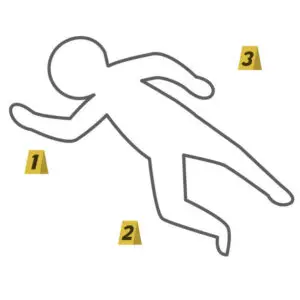
Homicide Investigations are Complex by Design
Your police report writing will be critical for the initial phase. As the first officer to arrive on this crime scene, you are the primary officer. You will remain at the scene with the responsibility to preserve and protect the scene; until, homicide investigators release you.
Police report writing will document, in chronological order, every event that occurs from the time you received the call; until, you clear the scene. You’ll list all notifications you make, and you’ll record the names and arrival times of every person who enters the crime scene. This includes paramedics; homicide detectives; crime scene investigators; medical examiner personnel and any other authorized persons. In effect, you’ll be the gatekeeper. It’s ironic that one of the easiest reports you’ll write will be for the most serious crime you’ll encounter.
The police follow-up report is particularly productive when follow-up investigations are actively pursued by police officers. If you join a police department that views the integrity of its reporting system seriously, you’re going to be writing a lot of follow-up reports.
Interviewing a Victim of Armed Robbery
This interview example deals with the crime of robbery; however, items can relate to other crimes as well.

Victimization in any form is a traumatic experience, but most people can’t image the trauma associated with violent crimes. I’ve chosen armed robbery, because it’s a crime of frequency in large urban settings. It can occur anywhere – on the street; in a commercial establishment, or in the form of a home invasion. Duration can be measured in seconds for a street robbery while the duration of a home invasion can seem infinite. In all instances, the possibilities for injury or death are present, and let’s not dismiss the humiliation and dehumanization aspects.
This is the victim you’ll be interviewing to accomplish your police report writing tasks. You’ll encounter victims who exhibit a range of emotions from rage to abnormal calm. Sometimes a victim will talk at length without providing relevant information, and other times the victim will be subdued offering little information. Your first task is establishing rapport with the victim, and the best way to start is by exhibiting patience.
Suspect Description

Once you gain a victim’s trust, you’ll be amazed how much relevant information the victim will be able to recollect. That recollection is nowhere more important than in providing you with a suspect’s physical description. There will be times when a victim knows the suspect; however, most robbery suspects are strangers to their victims. There’s no detail too minor to be included in your police report writing, and the suspect description fits this rule.
Sex
Most robbery suspects will be male; however, females are just as capable as males to commit robbery. Females will usually present as suspects when there are multiple suspects.
Race
Your department will have guidelines on how you designate race in your police report writing.
Age
This one should be simple, but it’s not that simple. When you ask the victim for the suspect’s age, the victim may well reply, “I don’t know.” Some police officers will take that reply to omit age from the suspect description. You already know that the suspect is probably between the ages of 15 and 50. It’s a simple task to obtain an estimation of the suspect’s age from the victim.
Height
When you ask a victim about the suspect’s height, you already have two models to go by. You know your height, and the victim knows his or her height. Some up and down hand movements by the victim will provide a fairly accurate estimation of the suspect’s height.
Weight
Weight is more problematic, but terms like thin; stocky; muscular; large belly, etc., will aid in providing a weight estimate.
Eyes
Eye color will be the primary question, but always ask the victim about any abnormalities. Eye abnormalities that can be noticeable include crossed eyes; pink eye; pupils of different sizes, drooping eyelids and protruding eyes.
Hair
Hair color, length and style can be changed, but they’re still important identifying factors. Facial hair: mustache; beard; goatee, etc.
Complexion
The generic descriptions for complexion are light, medium and dark. Take extra care when both the victim and suspect are people of color. These victims may determine a suspect’s complexion in relation to their own. For example: a black victim of very dark complexion may describe the suspect as light complexion when, in fact, the suspect is medium complexion. Just point this out to victims, and they will understand and adjust their response if needed.
Clothing
Clothing can be changed, but it’s a critically important part of the description. When you respond to the victim immediately after the robbery, you must get a description out as quickly as possible. Other police units will be expecting a suspect description consisting of sex; race; age; height; weight and clothing.
Identifying Characteristics
By the time you get to this point, you’ve stimulated the victim’s hippocampus – that part of the brain responsible for retrieving episodic memories. Here’s where the victim may recall unique physical traits about the suspect like scars, tattoos, a missing finger tip, etc. The condition of teeth to include braces; uneven; missing; chipped teeth, or teeth with visible silver or gold crowns.
Estimating Time can be a Problem

The victim of a street robbery tells you she can identify the suspect, because she got a good look at his face. You ask her how long she looked at his face, and she replies, “A couple of minutes.” She’s not lying, but she’s probably overestimating the time since two minutes is a very long time. More effort by you will bring that down to a more realistic observation measured in seconds. You may not think it’s an important detail, but that detail will be important if the case gets to trial. The defendant’s attorney will make a jury aware of how long two minutes can be.
The Suspect's Weapon
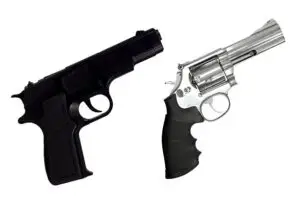
Any blunt force object of sufficient weight and size capable of inflicting injury can be used as a weapon. Edged weapons include knives and any sharp objects capable of slashing and stabbing. The ultimate weapon is the handgun, and you’ll be describing two types. The semi-automatic pistol and the revolver are both technically semi-automatic in their operation, because both fire one round with each pull of the trigger. However, each appears significantly different, because the revolver has a rotating cylinder in the center of the gun. Police report writing is about details, so describe weapons as accurately as possible.
Statements and Methods by Suspect
You’ll read a robbery report, and you’ll see this sentence. “The suspect demanded money from the victim.” This is fine… as far as it goes, but what – exactly – did the suspect say and how did he convey the demand?
For example: The suspect pressed the barrel of his gun against the victim’s forehead, and he shouted, “Give up the money, bitch!”
You can be certain your suspect has made the same statement and use of the gun when committing past robberies. Just as importantly, the suspect will use the same statement and method when committing future robberies.
Property Description
The description of property taken should be as detailed as possible. Let’s look at two examples of property taken from a female robbery victim:
U.S. Currency – $300.00 / One (1) Diamond Ring – $3,000.00
Okay, you’ve listed the property for a total value of $3,300.00, and you’re ready to move on. Did you ask the victim about the denominations of the currency? She probably knows since she withdrew the cash from an ATM just moments before the robbery. She was wearing an expensive ring, so she probably knows the ring size. She’ll be able to describe the type of setting, the karat size, and the cut of the diamond. Never forget, police report writing is always about the details.
Downgrading crime occurs when police officers purposely or otherwise misclassify crimes reported by way of Uniform Crime Reporting. The FBI’s Uniform Crime Reporting (UCR) system was created in 1930. While voluntary, nearly all police departments participate by reporting crime to UCR.
Uncooperative Victims
The uncooperative victim may just hate police, but don’t take it personally; it’s an occupational reality. Anybody can become a victim, and you’re obligated to give all victims a professional level of service. You just have to wear down the uncooperative ones, and asking questions relentlessly is the best way. It doesn’t always work, but they usually come around.
Scenario
You’re on patrol when you see a man sitting on the front steps of a row house. He’s bleeding from his head, and his arms show multiple bruises. As you walk close to the man, it’s apparent he’s a victim of assault. He tells you he was attacked with a piece of rebar, and his wounds are consistent with the rebar description. The wound to his head looks serious, and you suggest calling for an ambulance. The victim adamantly refuses medical assistance. During the course of your ensuing interview, you’ll offer medical assistance several times, and the victim will refuse.
Aggravated Assault
As the victim holds his folded tee shirt against his head wound, he begins describing the attack. His description is detailed, and he refers to the suspect by the name, “Zeke.” The suspect is known to the victim, and his event description establishes that he is the victim of Aggravated Assault.
Victim Becomes Uncooperative
Everything is fine; until, you ask for the victim’s name and address. He refuses to provide you with any identifying information. The victim’s not hostile toward you, but he’s no longer going to cooperate. You try to explain that you need the information to properly report the crime, but he’s not interested. He tells you he’s not making a report; even though, he’s already reported a crime. All your efforts fail, and the victim walks away.
Witnesses
You begin knocking on doors, and you locate several witnesses in the block. The witnesses corroborate the description of the assault, but neither the victim nor the suspect is known to the witnesses. They believe both men are strangers to the neighborhood, because they’ve never seen either man in the past. The witnesses provide a physical description of the suspect, and the weapon used.
UCR and Police Report Writing
Under the FBI’s Uniform Crime Reporting, Aggravated Assault is a Group A Offense. When you’re dealing with Group A Offenses, police officers, no matter their rank, often experience brain freeze. When you submit this report with the victim listed as unknown, you might well experience some grief. Some might suggest that this report be classified as “Injured Person.” By this logic, an unknown murder victim with multiple gunshot wounds could be classified as “Dead Body.”
UCR Group A Offenses are used to track certain crimes across the United States. These are the crimes that establish the nation’s crime rates. So, it’s obvious why the Group A Offenses addle the brains of police officers and particularly police chiefs.
Elements of Crime Established
The victim’s description, your observation of the injuries, and the witnesses’ statements all establish the elements of the crime. Even if the victim had refused to provide any information, your observation of the multiple injuries alone would be enough. You would just have more unknowns.
Once you’ve established the elements of a crime, you must report that crime. Some police officers might simply walk away, because the victim said he wouldn’t report the crime. Another officer might go the injured person route, but this officer’s brain freeze might thaw as he’s writing. He might realize he’ll have to ignore the elements of the crime, and he’ll have to lie by omission. Lying is not a good thing when it comes to police report writing. In fact, lying can get you fired no matter how stupid the reason.
The What If
What if the victim in this scenario goes to sleep that night, and he never wakes up? It turns out that rebar fractured his skull, and he’d probably be alive had he listened to you. You did all you could do, and your efforts will be appreciated by the homicide detectives investigating his murder. They’ll hit the ground running with a suspect’s probable nickname, physical description and three eyewitnesses.
The miscellaneous incident report – MI – can be used to document any incident that is not designated under other reporting criteria. The importance of the MI cannot be overstated, because the miscellaneous incident report affords you the means to document anything you can imagine.
Artificial Intelligence (AI) and Your Body Worn Camera (BWC)

AI to the Rescue
Police report writing has gotten a lot easier thanks to artificial intelligence. The audio from a police officer’s body worn camera can be interfaced with the department’s records management system (RMS). This means that you can begin your police report the moment you activate your BWC. For example, you can immediately begin dictating information for your report like your name; date; time; location, and other basic information you’ll need for any report.
Here’s the really fantastic part. AI generated police report writing can produce a written report in seconds that might take you an hour or more. However, there are always caveats to something this good.
First: During the course of your investigation, you’ll have to dictate all relevant information to be recorded by your BWC. Even AI can’t produce something from nothing. Practice makes perfect in this regard, because over time you’ll get proficient at dictating your information and narratives.
Secondly: You’ll have to read your report and make any necessary edits to the report.
Third: A supervisor must review the report, before it is entered into the system. Here’s some good advice. Never depend on anyone to identify your mistakes. Supervisory review is critical for a host of functions to include police report writing, but never take it for granted. You’ll always be responsible for every word in your report.
The Critics
There are critics of AI assisted police report writing, but you can discount police criticism since police officers criticize everything. Next come lawyers. Prosecutors worry that misstatements could appear, because the police officer fails to properly review and edit the report. This, I’m sorry to say, is a valid concern.
You really can’t take too seriously any criticisms by defense attorneys. Any defense attorney, worth his or her fee, loves poorly written; inaccurate and incomplete police report writing. Their only worry is that the AI assist will result in higher quality police reports.
This is a must read article from Axon.com.
The unfounded report should be the most easily understood report.
In police departments where it’s most popular, it’s the most misunderstood.
Police Report Writing is a Measurement of Your Integrity
It’s true that police report writing does not make the top 10 list of things police officers like to do. In fact, you won’t find it in the top 100; nevertheless, it’s a task with which you’ll be burdened.
The proper construction of a police incident report is important indeed; however, it’s not the most important aspect of police report writing. You’re going to work with some police officers who will expend more energy avoiding a report than writing one. It’s a popular complaint in police culture that writing reports limits the conduct of more important activities.
You’ll enter your police career susceptible to the advice of experienced police officers. Some of that advice will disparage police report writing, and you should ignore it as bad advice. You’ll get plenty of advice along the way, and you’ll get better at recognizing and ignoring the bad advice.
Here’s some good advice. Accept police report writing as a measurement of your personal integrity and competence. You’d be wise to heed this advice, because others will measure you by the quality of your writing skills. Your primary goal should be the establishment of a reputation for truthfulness and competence, and there’s no better way to achieve that goal than through police report writing.
Every police department will insist that accurate crime reporting is a top priority. When a department is embarrassed by an incident that exposes a flawed crime reporting system, the department’s leadership will always come up with the same excuse. They’ll say the incident resulted from an [isolated] procedural breakdown.
(NIBRS) Uniform Crime Reporting
(UCR Update: As of 2021, PART 1 and PART 2 Crimes are categorized as Group A and Group B Offenses respectively.)
Knowing how to classify crimes and report them properly is important for police report writing. The proper classification of a crime will ensure it gets the attention it deserves. Most police officers aren’t very well versed in UCR. In 2021, the FBI replaced the UCR Summary Reporting System (SRS) with the National Incident-Based Reporting System (NIBRS).
The ever increasing political importance of crime reduction has led to some bad habits. A lot of supervisors and police commanders have adopted creative interpretations for crime classifications. Your knowledge and understanding of UCR will keep you from developing those bad habits.
Important!
So many police officers to police chiefs try to reconcile UCR with their respective State Criminal Codes. It’s a fool’s errand, because one has absolutely nothing to do with the other.
Confusion over UCR (Uniform Crime Reporting) occurs when police officers try to compare UCR crime classifications with state criminal codes. Many will suffer confusion over UCR for their entire careers.
NIBRS Group A and Group B Offenses
There are 22 Group A offense categories making up 46 Group A offenses. The crime categories are listed below in alphabetical order.
Offense Code; Offense Description; Crime Against
Arson
200 – Arson – Property
Assault Offenses
13A – Aggravated Assault – Person
13B – Simple Assault – Person
13C – Intimidation – Person
Bribery
510 – Bribery – Property
Burglary / Breaking & Entering
220 – Burglary / Breaking & Entering – Property
Counterfeiting / Forgery
250 – Counterfeiting / Forgery – Property
Destruction / Damage / Vandalism of Property
290 – Destruction / Damage / Vandalism of Property – Property
Drug / Narcotic Offenses
35A – Drug / Narcotic Violations – Society
35B – Drug Equipment Violations – Society
Embezzlement
270 – Embezzlement – Property
Extortion / Blackmail
210 – Extortion / Blackmail – Property
Fraud Offenses
26A – False Pretenses / Swindle / Confidence Game – Property
26B – Credit Card / Automated Teller Machine Fraud – Property
26C – Impersonation – Property
26D – Welfare Fraud – Property
26E – Wire Fraud – Property
Gambling Offenses
39A – Betting / Wagering – Society
39B – Operating / Promoting / Assisting Gambling – Society
39C – Gambling Equipment Violations – Society
39D – Sports Tampering – Society
Homicide Offenses
09A – Murder & Nonnegligent Manslaughter – Person
09B – Negligent Manslaughter – Person
09C – Justifiable Homicide – Person / Not a Crime
100 – Kidnapping / Abduction – Person
Larceny / Theft Offenses
23A – Pocket-picking – Property
23B – Purse-snatching – Property
23C – Shoplifting – Property
23D – Theft From Building – Property
23E – Theft From Coin-Operated Machine or Device – Property
23F – Theft From Motor Vehicle – Property
23G – Theft of Motor Vehicle Parts or Accessories – Property
23H – All Other Larceny – Property.
Motor Vehicle Theft
240 – Motor Vehicle Theft – Property
Pornography/Obscene Material
370 – Pornography/Obscene Material – Society
Prostitution Offenses
40A – Prostitution – Society
40B – Assisting or Promoting Prostitution – Society
Robbery
120 – Robbery – Property
Sex Offenses, Forcible
11A – Forcible Rape – Person
11B – Forcible Sodomy – Person
11C – Sexual Assault With An Object – Person
11D – Forcible Fondling – Person
Sex Offenses, Nonforcible
36A – Incest – Person
36B – Statutory Rape – Person
Stolen Property Offenses
280 – Stolen Property Offenses – Property
Weapon Law Violations
520 – Weapon Law Violations – Society
Police Report Writing
Group B Offenses
There are 11 Group B offense categories, and they encompass all of the crimes that are not Group A offenses. The Group B offense categories are listed below in alphabetical order.
Offense Code; Offense Description; Crime Against
90A – Bad Checks – Property
90B – Curfew / Loitering / Vagrancy Violations – Society
90C – Disorderly Conduct – Society
90D – Driving Under the Influence – Society
90E – Drunkenness – Society
90F – Family Offenses, Nonviolent – Society
90G – Liquor Law Violations – Society
90H – Peeping Tom – Society
90I – Runaway* – Not a Crime
90J – Trespass of Real Property – Society
90Z – All Other Offenses – Person, Property, or Society
*Note: In January 2011, the FBI discontinued the collection of arrest data for runaways. Agencies may continue to collect data on runaways, but the FBI will no longer use or publish that data.
NIBRS 2011 U.S. Department of Justice—Federal Bureau of Investigation
Related Content for Police Report Writing
Resources
Police Sergeant, E-Commerce Owner, Author
International Association of Chiefs of Police
Writing Skills (ad)- This is The Elements of Style, the classic style manual, now in a fourth edition. A new Foreword by Roger Angell reminds readers that the advice of Strunk & White is as valuable today as when it was first offered. This book’s unique tone, wit and charm have conveyed the principles of English style to millions of readers. Use the fourth edition of “the little book” to make a big impact with writing.
Advertisements

